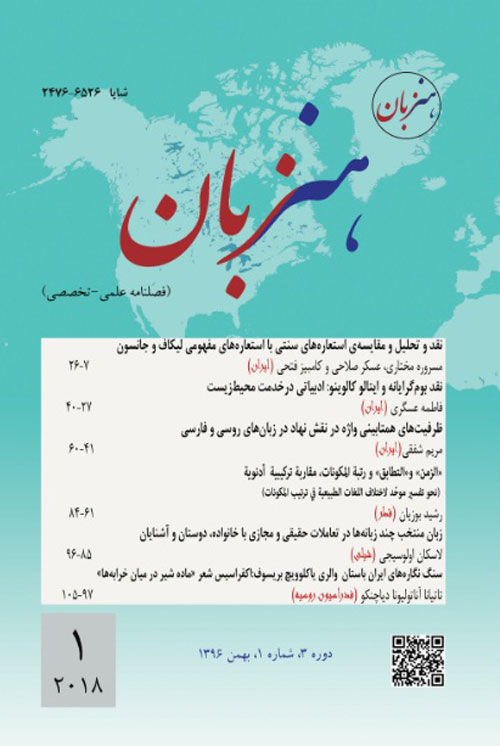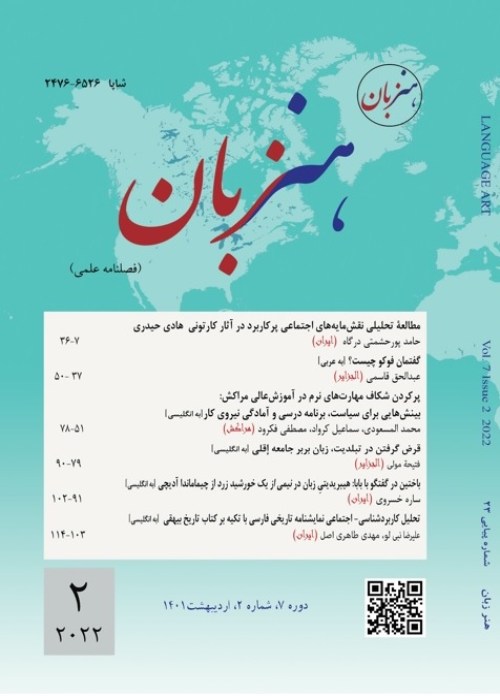فهرست مطالب

نشریه هنر زبان
سال سوم شماره 1 (بهمن 1396)
- تاریخ انتشار: 1397/02/25
- تعداد عناوین: 6
-
«الزمن» و «التطابق» و رتبه المکنونات، مقاربه ترکیبیه ادنویه / نحوه تفسیر موحد لاختلاف اللغات الطبیعیه فی ترتیب المکنوناتصفحات 61-84
-
Pages 7-26In recent years, metaphor has attracted the attention of scholars and poets as well as readers of literary passages because of including features like exaggeration, brevity, and artistic and literary beauty creations. According to the linguists, majorities of language materials as well as the most complicated scientific theories are understood by metaphor. Since several studies are done and published with the application of Lakoff and Johnson theory, there is a question concerning the similarities in two different attitudes in two languages and literary domains that they accorded and conceptualized. After the case study and library study about classic metaphor in old books and the content analysis and its comparison with metaphor with its new concept, the present study concluded that despite the existing similarities and differences, theory of cognitive linguists is relatively exaggerated and in most of cases, many suggested issues in contemporary theory is the same as concepts of classic eloquence theory which have been raised with different titles. Also, in spite of benefits, the contemporary theories left some issues related to classic metaphors unanswered and is not responsive to some eloquence questions considering the societys language and literary demands.Keywords: Eloquence Criticism, Metaphor, Conceptual Metaphors, Cognitive Linguistics, Lakoff, Johnson
-
Pages 27-40Eco-criticism, a branch of modern literary criticism, nowadays everywhere in the world, from West to East, and in the form of a cultural and moral flow, through literature announces its message as an alarm, a concern for the environment. Among the writers of contemporary Italian Literature, Italo Calvino is the first ecologic story-teller, who beyond his short stories reveals the emergency situation of urban ecosystem. The first character of his stories, condemned to live in industrial cities, is looking at nature disappearing in his smoky hands. The present article, through the content analysis of some of these works, points out to the important role of Literature which serves in the cultivation for preserving the environment and awakening the minds of humen against a serious danger that threatens their lives.Keywords: Eco-criticism, the Department of Literature, Environment, Culture in Favor of Environment, Italo Calvino, Contemporary Italian Literature
-
Pages 41-60Syncretism is the syntactic property of a member of the sentence that expresses more than one syntactic meaning all at once. The Syncretic nominative refers to one-member sentences in which the nominative is also the predicate at the same time. Furthermore, some adjectives, comparatives, and participles in Russian and Persian language are widely used as nouns and nominatives. Iranian grammarians discuss the syntactic properties in terms of nominal sentences (semi-sentences). Nominal sentences do not have verbs and, unlike one-member sentences, may comprise more than one member. One-member sentences are usually exclamatory syntactic structures with a special intonation. They are divided into two main groups based on their being voluntary or involuntary. Involuntary one-member sentences are used to warn the addressee about an immediate danger, attract his/her attention, or ask him/her to be careful, such as: Пожар! /pazhar/ (Fire!) or in Persian: ɂātiʃ!. Voluntary one-member sentences are used as a demanding action, such as Тишина! /tišina/ (Silence!) or in Persian: sāket!Keywords: Syncretism, Contention, Nominative, One-member Sentences, Adjective in Normative Case, Russian Language, Persian Language
-
Pages 61-84This paper sets out to re-examine the justification for assuming in MP (the Minimalist Program ) that Features of the functional categories are said to be either strong or weak with respect to their visibility at the interface. Strong AGR features are visible at PF if they are not checked off before the interface. Weak features are not visible at PF. By examining this hypothesis, I clarify the process by which the V-features of Tense and/or Agreement in verb-initial languages such as Arabic, Irish and other similar languages might be strong, and there are solid and reliable evidence that leads to believe that Verbs in these languages are forced to raise from the Verb Projection prior to spell-out generating V.S.O Word Order Paradigm. Regarding the subject and Complements of verbs in these languages (Verb-Initial L) , it is strongly believed, based on a variety of empirical evidence, that they remain in their original position within the V-Projection domain until after spell out when the N- features on functional heads are weak.Keywords: Tense, Agreement, Functional Categories, Strong features, Weak features, Generative Syntax, Minimalist Program
-
Pages 85-96The aim of the present study is to investigate and compare the choice of language used in an online platform (Facebook) and during offline communication with reference to a family member, a friend and an acquaintance in the same multilingual speech community. As part of this study, a structured sociolinguistics questionnaire was administered to 38 multilingual postgraduate students. This is followed by interviewing selected focus group to elicit more information on various factors that influence their language behavior. The major finding of this study is that apart from family circle, a majority of multilingual users in India prefer to use English for Facebook private communications only among friends and acquaintances while Mother tongue is the dominant language use for offline communications.Keywords: Multilingual, India, Facebook, Language, Family, Friend, Acquaintance
-
Pages 97-105This article is devoted to the genre of the architectural ekphrasis in the poetry by V. Bryusov. The article describes the main ways to create engraving of the literary work of The Lioness among the Ruins. Much attention is given to the verbalization of the oriental architecture (in particular the ancient Persian architecture) in the ekphrasis and the poetry rapprochement of the ancestor of Russian symbolism V. Bryusov with acmeism poetry especially the architectural literary works by O. Mandelstam. The article is of interest to post-graduate students, degree-seeking students, and can be used in writing thesis and term paper.Keywords: Ekphrasis, Oriental Architecture, Engraving, Verbalization of Architecture, Image


